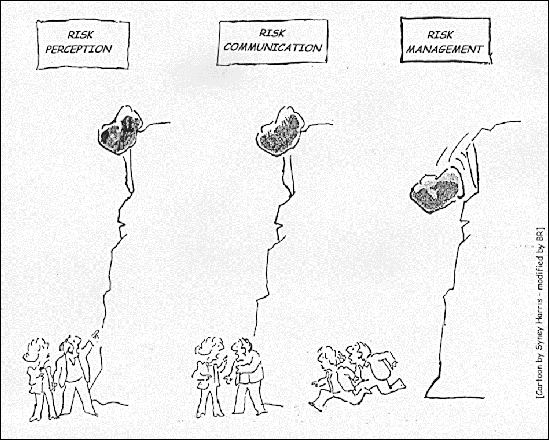 |
Editorial
|
 |
Editorial
|
Humans are exposed to risks wherever they are - in their homes, at work, during leisure activities or while commuting. A multitude of hazards - ranging from natural to technology-induced events - can affect the health and life of people as well as their assets, depending on the vulnerability of individuals and the community at large.
Residents, employees in the workplace, consumers of potentially hazardous products, travellers and so on want to or need to be informed about risks (e.g., from radiation or drugs); health and safety authorities want to influence and change people's risk attitude and behavior (e.g., regarding driving, gambling, smoking); communities have to be prepared for emergencies and disasters (e.g., chemical spills, floods, fires); and in the case of controversial risk sources (e.g., the siting of an airport or a waste incineration facility), public discussion, participation of stakeholders and possibly joint conflict resolution are required. All these situations involve social processes which are usually subsumed under the (umbrella) term "risk communication", and the exchange of risk information between interested parties (individuals, groups, institutions) is at the core of it. This happens in a wide range of 'arenas', from systematic campaigns planned by authorities to informal exchanges in occupational or private contexts.
Consequently, risk information and communication has become a very active field of research and application. There are several journals (e.g., Risk Analysis, Journal of Risk Research, Risk: Health, Safety & Environment), professional societies in Europe, USA and Japan, annual congresses and a large number of WWW sites, all indicative of the high relevance of risk issues.
In this volume of the Australasian Journal of Disaster & Trauma Studies, five articles tackle a wide array of risk information and communication problems. The authors, Janet Gough, John Handmer, Bernd Rohrmann, Britt-Marie Drottz-Sjöberg and Holger Schütz & Peter Wiedemann come from five different universities or research institutes in New Zealand, England, Australia, Norway and Germany, and their backgrounds are a blend of social and natural sciences. Four articles present empirical observations, two dealing with natural hazards (Gough, Handmer) and two with technology-induced hazards (Drottz-Sjöberg, Schütz & Wiedemann), while the fifth contribution (Rohrmann) is a theoretical treatise, a generic model of the risk communication process. The findings are based on data collected in nine countries, New Zealand, Australia, England, Germany, Sweden, Poland, Ukraine, Belarus and Russia. This diversity might be a bit confusing for readers new to the field - however, it reflects the scale of risk information/communication issues. There are no general and straightforward principles (the once-proposed "seven cardinal rules" for communicating about risks seem rather narrow and - in hindsight - simplifying a rather complex matter); nor can there be one all-encompassing theory of the risk information/communication process.

In line with this perspective, all five authors connect their analysis of risk information and communication processes to risk perception data, and they discuss implications for the conceptualization and conduct of risk management efforts. While the articles differ in focus and scope, they indicate some common viewpoints and lessons: that risk issues are complex matters beyond technical features, that researchers have to and can reflect this complexity, and that the transformation of research results into risk information/communication campaigns calls for a socio-psychological approach.
Finally, interdisciplinary co-operation across different scientific disciplines as well as between researchers and public authorities seems the best way to enhance further the validity and usefulness of risk information and communication efforts - and there's quite a bit left to do! Hopefully the articles presented here will encourage the reader to appreciate and utilize the potential of this line of research for comprehensive hazard and disaster management.
To conclude this preface, I thank the editor of the Australasian Journal of Disaster & Trauma Studies, Douglas Paton, for the opportunity to organize and edit this special volume. Thanks too to all who participated in the review process - and of course to Harvey Jones who patiently converted rather heterogeneous manuscripts into the electronic format of this journal.
| Comments to Trauma.Webmaster@massey.ac.nz Massey University, New Zealand URL: http://www.massey.ac.nz/~trauma/ |
Disclaimer
Last changed October
16, 2000 |